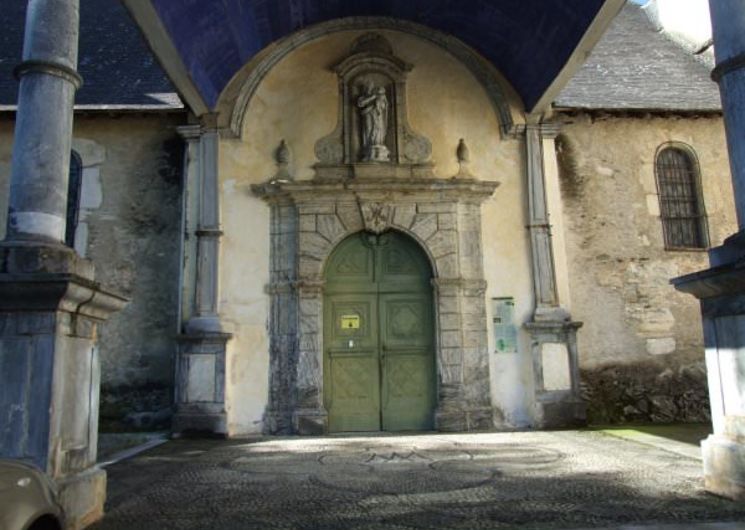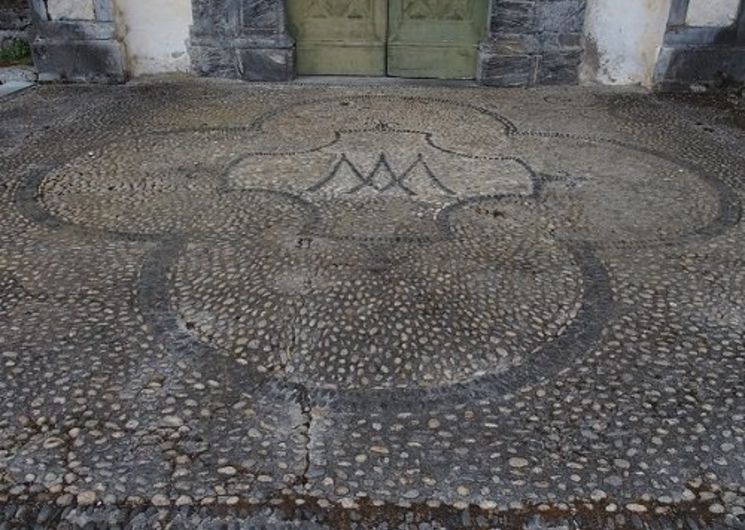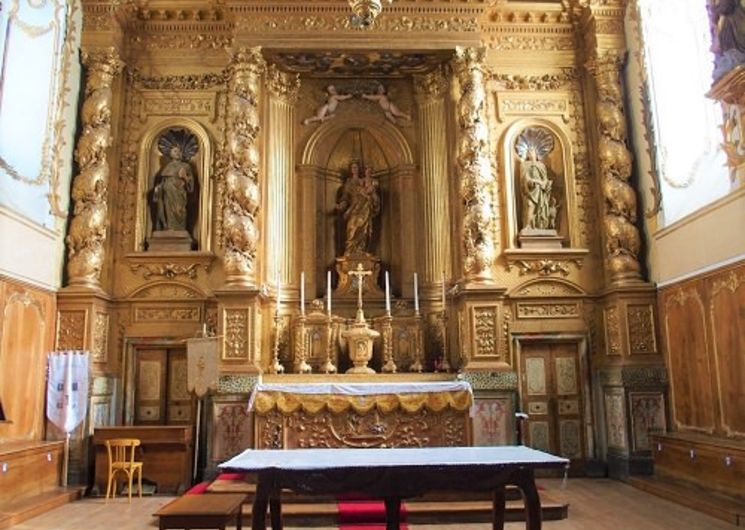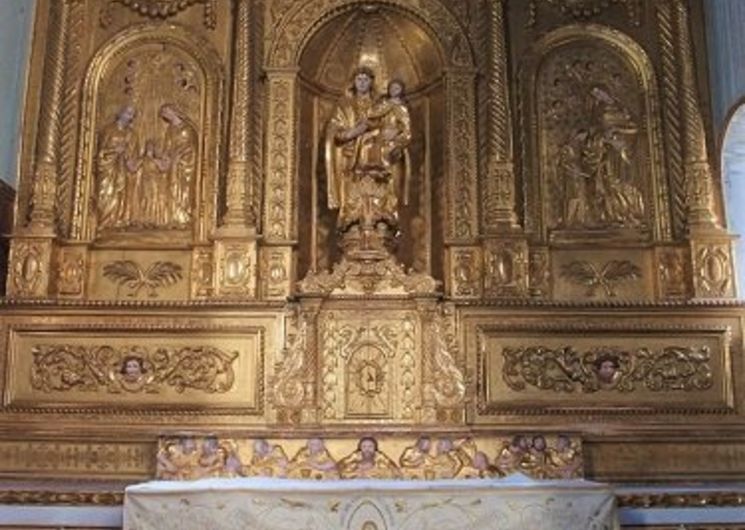CHAPELLE DE POUEY-LAÜN
ARRENS-MARSOUS , Hautes-Pyrénées – Cultural heritage
About
The chapel of Pouey-Laün is the chapel with the bell tower built on a rock (mount of the source) located outside the village. The site is an ancient Roman oppidum at 930m altitude, before becoming a religious site. The chapel, built in the Middle Ages, was used as a place of prayer for pilgrims who went to the sanctuary of N.-D. de Pilar de Saragossa. The origin of these pilgrimages dates back to 1350, when, as some recent discoveries seem to prove, pilgrims from Zaragoza were joined by those passing through on their way to Santiago de Compostela via the Peyre San Marti pass, with the construction of a hospitalet. All that remains of this hospitalet is a door lintel engraved with the year 1590, which is embedded in a wall of the Arrens parish church. The chapel was rebuilt and enlarged in the 18th century (1684-1766), following the major earthquake of 1660. Sold as a national asset in October 1795 to four inhabitants of Argelès-Gazost, they had great difficulty in recovering their property in the face of the anger of the inhabitants of Arrens. They got rid of it quickly by selling it to Mrs Anne GLÈRE of Arrens. All the archives and statues, (except two statues: Mary and Saint Roch) were burnt when it was transformed into barracks in 1806, during the Spanish war. It was restored in 1807, following the intervention of Hortense de Beauharnais with the Emperor, and reopened to worship on 5 May 1808. But in 1812, with the Spanish war, the sanctuary was used as barracks. Anne GLÈRE bequeathed the buildings to Michel POME, her relative, who handed them over in 1836, following a royal decree, to the factory of the church of Arrens. Restored after the earthquake of 1854, it was the bishop of Tarbes, Monseigneur Laurence, who subsequently undertook the restoration and entrusted the management, as in Héas, to the fathers of Garaison in 1855. He offered the sanctuary a relic of Saint Anne. This gave rise to imposing processions from 1857 to 1900. After having disappeared, it was recently found in one of the drawers of the sacristy. It was “put back into service” in a magnificent gilded wooden shrine after the celebration of a great mass by Bishop Perrier. The building has been classified as a historical monument since September 1954. In 2016, the site was used as a set for the film based on the detective novel “Glacé” by Bernard MINIER, turning it into a high-security psychiatric hospital. Unfortunately, the beauty of the site is somewhat deteriorated by the presence of a medical institute with a rather questionable aesthetic. This establishment, initially a novitiate of the Missionaries of the Immaculate Conception (Fathers of Garaison) became a college, then after transformations in 1922, a preventorium for children, and in 1936, a Jean THÉBAUD sanatorium, then a medical institute in 1973. This is the building we see now. It has just been closed permanently. This is where the hospitalet for pilgrims used to be. The only thing left of this hospitalet is the lintel which is on one of the walls of the church of Arrens. It is dated 1591. The entrance of the chapel, classical, with its marble frame is surmounted by a statue of the Virgin. It is protected by a baldachin serving as a porch. Built in 1785, collapsed in 1820, the baldachin was rebuilt later. The bell tower, a square tower, dates from 1684, the date of the fleurdelisé bell it houses. The floor is a beautiful calade. Inside, all the gilding gives the impression of being in a rococo theatre. Tradition has it that the high altar was a gift from Louis XIII (1638) following his devotion to Mary and his request for the protection of France by the mother of Jesus, commonly called the vow of Louis XIII (1632-1638). It was restored in 1890. The floor, made of rough granite, partly from the rock itself, was made in the 19th century by quarrymen from Lourdes. The vast U-shaped balustered tribune where the pilgrims (men) used to crowd is a rare shape in Lavedan. The beautiful blue ceiling, typical of the late 17th century, represents a starry sky. The gothic hanging keys are painted. The triple altarpiece or screen altarpiece, with four imposing twisted columns adorned with pampers, is surmounted by a pediment where an Assumption of the Virgin surrounded by angels’ heads shines; it is usually attributed to Marc FERRÈRE (1674-1758). The central statue of the Virgin (N-D de Poueylaün) saved from the Revolution is framed by the later statues of Saint Peter and Saint John. Made around 1850, they replace those destroyed around 1793. The tabernacle represents, on its door, a pelican, symbol of Christ who gives his person to save his children. The grid decoration is supposed to be an imitation of the decoration of Louis XIV’s bedroom in Versailles. The chandeliers were donated by a local family in 1919. There is also said to be a chandelier donated by King Louis XIII.
The large wooden grille at the back of the gallery has beautiful carved wooden panels, the motifs of which are reminiscent of the decorated staircases of certain bourgeois houses. This grille was originally intended to separate the choir from the nave. The altarpieces in the side chapels are dedicated to Saint Anne and Saint Joseph. The altarpiece of St. Joseph with twisted columns, pilasters and side wings was reconstructed in 1863, with composite elements, some of which are from the 17th century. The probable central painting was replaced after the Revolution by a statue of the saint. The altarpiece of Saint Anne represents Anne holding the Virgin in her arms. It is framed by two bas-reliefs representing the Childhood and the Education of the Virgin. It was entirely rebuilt after the damages of the Revolution by a local sculptor, Pierre SOUSTRIC, in the 1850s. The tabernacle houses the hunting of the relics of Anne. The tribune houses the old rood screen (wooden grille) which separated the nave from the choir. The sacristy exhibits carved wooden sideboards.
Sources: www.patrimoines-lourdes-gavarnie.fr
Free guided tours in July and August. From September to June, ask for the key at the Maison du Val d’Azun-Office de tourisme. Traduction automatique par DeepL via DATAtourisme
Spoken languages : French – English – Spanish
Services
Services
- Visites groupes libres
- Visites groupes guidées
- Visites individuelles libres
- Visites individuelles guidées




